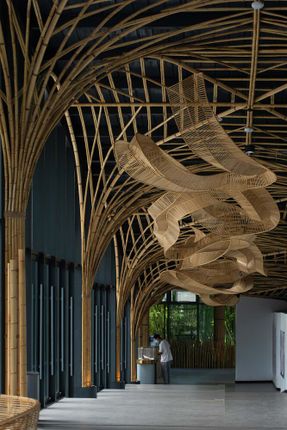Qionglai Bamboo Pavilion
ARCHITECTS
UNO Architects
CLIENT
Chengdu Cultural Tourism Group
BAMBOO STRUCTURAL ENGINEER
Sichuan Daoming Bamboo Industry Development Co., Ltd.
CONSTRUCTION DRAWING
Kan Wang ( Project Leader), Jingjing Chen, Chaosong Chen, Pengze Qu
DESIGN TEAM
Qingqing Yang, Kexuan Ning, Jianyuan Wang, Hanlin Li(Intern), Yunchen Lei, Rongpeng He, Yue Zhao, Hui Yuan
PROJECT ARCHITECTS
Tao Dong, Chenxi Wang
CONSTRUCTION DRAWING DESIGN
Si Na Yu Lian Architecture Design Co., Ltd.
YEAR
2022
LOCATION
Chengdu, China
CATEGORY
Museums & Exhibit
Text description provided by architect.
Qionglai Bamboo Pavilion is located in a small traditional rural community at the north end of the Baimo river bridge, next to over 100,000 acres of bamboo forest. For hundreds of years, Linpan settlements have been traditional rural communities in the western part of Sichuan.
Often covered by woods, especially groups of bamboo, Linpan is an organic combination of woods, fields, houses, and water, it’s a reflection of the harmonious relationship between land and its people.
That’s why famous local poet Su Shi from Song Dynasty said: “Better having no meat in eating, than having no bamboo in living.”
When we talk about the beauty of the bamboo forests, the first thing that comes to mind is a tranquil path that leads deep into the bamboo forest and the sun plays off the trees.
We try to see it from another perspective, endless bamboo forests follow the gentle curves of the landscape like rolling waves in the sea.
Our design aims to capture this moment, define the elegant curves shaped by mother nature and express different layers of nearby bamboo forest.
THREE IDENTITIES
The Bamboo Pavilion carries three identities.
First, it’s a visitor center to the Bamboo forest scenic area where quick facts and exhibitions can be found about the breathtaking natural beauty secondly, it hosts intangible cultural heritage workshops that demonstrate local craftsmanship using bamboo materials for generations.
And finally, it's a village center for local residents, providing convenience for various activities from relaxing, and dancing to public gatherings.
Two roofs peel off the landscape, one is facing the village entrance, welcoming guests from all over the world, and the other is facing the bamboo forest, the beginning of another journey.
These two interlocking roofs created a public courtyard, which can be easily transformed into an outdoor exhibition area when needed.
But before any exhibition happens, it has already been occupied by locals as a dance floor.






















